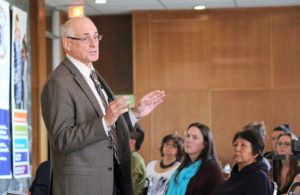Panel discusses the Robinson Huron/Superior Hennessy verdict

By Catherine Murton Stoehr
SUDBURY—This past week, Sarah Rice, Director of the Indigenous Portfolio at the University of Sudbury, hosted a panel to facilitate knowledge sharing in the wake of the Honourable Patricia Hennessy of the Superior Court of Canada’s historic decision in the first of three possible trials of the Robinson Huron/Superior treaty claim.
Speakers addressed issues arising from the verdict from multiple levels of magnification.
Gimaa Kwe Valerie Richer of Atikameksheng Anishnawbek, like all of the speakers, was emphatic that she was speaking on her own account and not for the Robinson Huron Chiefs, the Robinson Huron Litigation Trust, or its legal team.
Taking a wide angle on the case Gimaa Kwe Richer asked the audience to consider its national context. How it is that Canada is a legitimate nation-state?
“We never lost a war, we weren’t conquered, and we were never asked to join Canada.”
Gimaa Kwe Richer suggested that students could better understand Canadian legal assumptions by investigating the concept of “assumed crown sovereignty” (presumably a legal justification for the imposition of Canadian political authority on First Peoples).
Referencing TRC call to action #45 that calls upon the Government of Canada to “Renew or establish Treaty relationships”, the Chief said that Treaties ensure rights but also bestow obligations, “such as understanding what the treaty is, respecting the territorial boundaries, educating yourself and your children.”
Noting that the Robinson Huron Treaty is “a sacred treaty because it was conducted in ceremony and was forward-looking in terms of future generations,” Gimaa Kwe Richer concluded with the question, “how come we don’t have a monument to our treaty?”
Mike Restoule, chair of the Robinson Huron Treaty Litigation Trust, took the mic and focussed in on some of the history of the litigation and the treaty.
Restoule echoed several of the themes laid out by Gimaa Kwe Richer — the call for shared treaty responsibility, respect, and renewal, adding on the concept of reciprocity. Speaking directly to the verdict, Restoule shared that it “recognized the Anishinaabe perspective of the treaty and that was very important to me as an Anishinaabe person” the judge had enjoined the Crown to “respect the jurisdiction of the Anishinabek over the territory.”
Restoule noted that the Anishinabek story of the woman who married a beaver, shared with the court by professor Heidi Kiiwetinepinesiik Stark, was critical to their understanding that the Anishinabek had and continue to have responsibilities to each other, the land, and all of the plants and animals.

Questions from the audience revealed that some are thinking about the litigation in ways that might not occur to people steeped in the language and protocols of the Canadian courts. The first question returned to the wide view of Gimaa Richer’s remarks, questioning the ethics of Justice Hennessy’s reference to the treaty as an instrument of land surrender (cessation) in the verdict. One panelist, a former judge, the Honourable Stephen O’Neill, responded that the reference to cessation was one sentence on the first page in a verdict of over one hundred pages and not pertinent to the only question put to the judge, which was: was the four dollar cap fixed?
“We are very happy with how the court answered that [cap] question.”
O’Neill celebrated the verdict’s acknowledgment of the Treaty of Niagara, first recognized by the courts in 2000. He said that in that case, there was less relevant expert testimony. The 2018 Robinson Huron/Superior verdict drew on Alan Corbiere’s extensive testimony about Niagara that facilitated a verdict he claims is very different from that of 2000, one that “breathes life into the understandings of Niagara.”
Question period revealed an information imbalance between panelists and listeners. Some audience members were focussed on specific matters. Concerns about how a payout of settlement money might actually harm community members were met with general answers, even in one case where the questioner’s concern that convicted violent prisoners might buy their freedom and return home to harm community members could have been laid to rest.
Listeners hoping for specific information, such as what the current state of the negotiations are, the likelihood of Ontario proceeding with an appeal of the Hennessy verdict, what they could expect in terms of years and decades of delay in a worst case scenario in which litigation proceeds through all three of the agreed-upon phases, with the first appealed by Ontario and the following two appealed by both levels of government, left no further ahead. There was a suggestion that asking and answering such questions could harm the outcome of the process in some way. An explanation of how such discussions have harmed outcomes in similar situations could promote understanding outside of legal circles.


